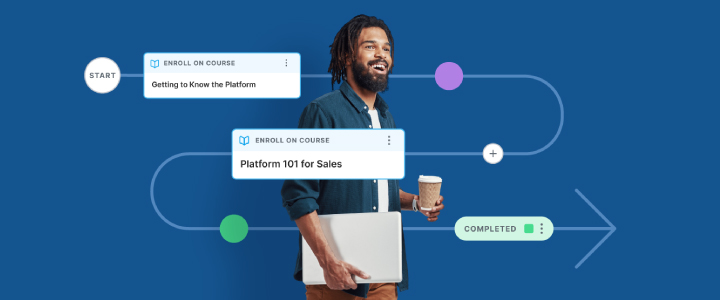
6 min reading time
4 Essential Questions to Drive Strategic Alignment on Learning Programs
While there’s no magic formula to guarantee success, strategic alignment is one of the key differences between organizations that perform well and those that don’t. In fact, research from Brightline, a Project Management Institute, found that strategic alignment is what the top 10% use to hit their business goals. Given the potential strategic alignment holds, it’s worth determining if your company has the opportunity to focus on this key ingredient to success.
In this blog post, we’ll explore four questions companies can ask to determine their current level of strategic alignment, specifically around learning programs. But before we dive in, let’s think about what strategic alignment is and is not. Strategic alignment is not “return on investment”, and if you’re simply using financial measures to evaluate projects, chances are you’re not aligning them with strategy. So let’s start by establishing what strategic alignment really means.
What is strategic alignment?
“Strategic alignment means that all elements of a business — including the market strategy and the way the company itself is organized — are arranged in such a way as to best support the fulfillment of its long-term purpose.”
Put simply, strategic alignment refers to the process of ensuring that an organization’s goals, strategies, and actions are coordinated and consistent with each other. It involves aligning the various parts of an organization, such as its business units, departments, teams, and individuals, towards a common vision, mission, and set of objectives. Applying this definition to a company’s learning and development efforts would mean a shared focus and commitment across the company to learning objectives, initiatives, and resources.
The importance of strategic alignment
“Tying learning outcomes to business outcomes should be a cross-functional effort, with alignment agreed before launch.”
– Aisling MacNamara, Senior Learning & Development Manager at LearnUpon
As basic as this sounds, many learning programs are deployed to impart some skill or knowledge. They are not directly tied to business goals, but may be used to improve sales skills to boost revenue, or safety training to ensure compliance. Whatever the learning initiative, it should be based on business needs. Yet just 38% of companies say their business objectives are strongly tied to development objectives such as specific competencies and skills.
Complete alignment across senior leaders and stakeholders is critical to the success of any learning program. It’s simply cause and effect. Better alignment leads to more impactful learning experiences. L&D teams are often tasked with designing, creating, and delivering learning programs that fulfill ambitious leadership expectations. Fully understanding those expectations is key to alignment and delivering training programs that satisfy participants’ and leaders’ needs.
Common learning challenges that can be solved through strategic alignment
To overcome learning challenges, it is critical to align L&D initiatives with the expectations of the leadership team. This helps ensure that all stakeholders understand the value of learning, that there is visibility into the programs being developed, and that the L&D team is clear on the goals they are working towards.
Among the challenges are:
- Balancing short-term needs with long-term goals: Organizations may be tempted to focus on short-term training needs, such as addressing immediate skill gaps, rather than investing in long-term development initiatives that support the organization’s overall strategy. However, it is important to strike a balance between short-term and long-term training goals.
- Limited resources: Organizations often face resource constraints for learning and development initiatives. Strategic alignment can help ensure resources are used effectively and efficiently, by prioritizing initiatives that align with the organization’s overall strategy and goals.
- Resistance to change: Learning initiatives often require individuals and teams to change the way they work or think. Resistance to change can hinder successful learning initiatives. Strategic alignment can help overcome this challenge by ensuring that learning initiatives are designed with stakeholders’ needs and perspectives in mind.
- Lack of buy-in: Without buy-in, learning initiatives are unlikely to succeed. Strategic alignment can help build buy-in by involving stakeholders in the planning and design process, and by demonstrating how learning initiatives align with the organization’s overall strategy and goals.
- Limited impact: Even when learning initiatives are successful, they may have limited impact if they are not strategically aligned with the organization’s overall strategy and goals. Strategic alignment can help ensure that learning initiatives have a measurable impact on organizations’ performance and bottom line.
How to achieve strategic alignment
We recommend using the following questions, especially in the run up to new training initiatives, to encourage alignment, and expected outcomes and value.
1) What are the key learnings you want a participant to know after attending the program?
This question helps establish the most important things learners should know upon completing training. Leaders often expect learning outcomes outside of the program’s scope. Asking this question early in the process creates an ideal opportunity to tie it back into the specific objectives and goals of the program.
You may need to work with the leader to help them understand why their expected outcome doesn’t align with the overall objectives, but that it can be built into a subsequent program.
2) What key performance indicators would you expect to see improve?
“Organizations must develop specific outcomes to the learning initiatives that point directly to the desired behavior changes or skill acquisitions.”
– Where Learning and Performance Converge, Brandon Hall Group
Whether a KPI is for a one-off campaign or a long-term initiative, it can help teams track their progress and improve results. Once learners have completed a program, we want them to implement their learnings, and ultimately change or improve their behaviors. Anchoring to key performance indicators (KPIs) can help determine if learning was effective. For example:
- A demonstrable knowledge of a new sales technique
- Ability to identify all the features of a new product/service
- An understanding of a new software platform
It is useful at this stage to identify the leading and lagging indicators of the program. In other words, what can we expect to improve soon after the training? And what is a long-term metric to determine if the program has been successful? For example, if you’re developing sales training, the leading indicators may be activity metrics and pipeline generated. A lagging metric is the percentage of sales reps who hit quota next quarter.
3) What would we need to show in order to demonstrate that the program has been successful?
This question is a hybrid between questions one and two, where the answers can be both qualitative and quantitative. Here, you can gauge whether your stakeholders are completely focused on ROI, or have a more holistic approach to learning. By discussing this question, leaders will hopefully gain a better understanding of which outcomes will be easy to demonstrate, and which might be a little more subjective. This question can also help you plan what you will need to communicate after the program to demonstrate success and reinforce alignment across key stakeholders.
4) How would you determine a positive return on investment for the program?
Whether it’s skill acquisition, increased win rate, team engagement with training, or something else, demonstrating the ROI of any learning program is especially challenging without stakeholder input. This question removes the guesswork by asking them directly what a positive ROI would look like for them.
We’ve found that the answers to this question can sometimes be surprising. For example, we recently launched a training program that required a significant investment of resources. And while all the stakeholders wanted to see the KPIs improve, the main ROI they wanted to achieve was cultural — they wanted our team to enjoy their roles and feel successful.
How we drive strategic alignment at LearnUpon
If we’re launching a large training event, we seek alignment with relevant stakeholders at the beginning and middle of the program build.
The first step is to align on performance-based goals and outcomes such as KPIs, tying learning to revenue growth, time to launch, and so on. When we’re 3 weeks from launch, we email the following questions to key stakeholders. We review their answers and have a final alignment call, where we discuss goals around learner experience and overall company outcomes, and also set expectations around post-launch follow up and measurement.
Strategic alignment should be a goal within your learning program
While strategic alignment doesn’t guarantee the success of your learning initiatives, it should be a goal of your learning programs. This is to ensure they’re relevant, effective, and impactful in supporting the organization’s overall goals and objectives.
By developing a learning strategy where performance is the outcome, not just learning itself and including the questions in this post within the process, you can increase support from leadership, improve learner satisfaction, and set your organization up for future success.




